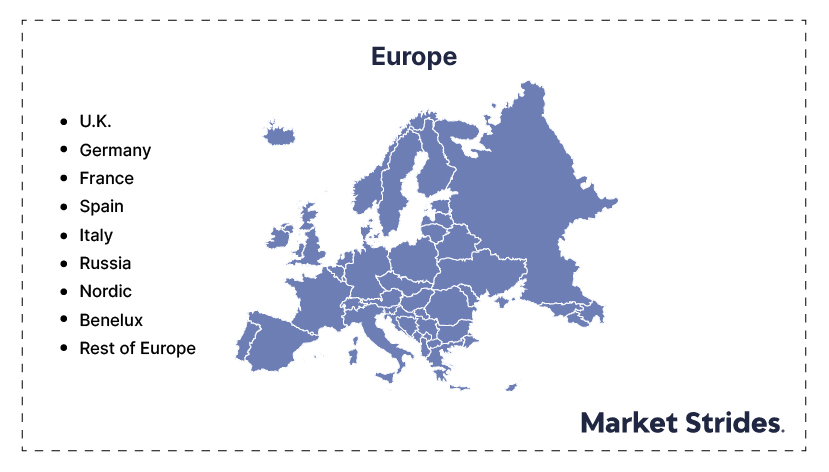The Europe flutamide (CAS 13311-84-7) market size is expected to grow at a CAGR of 4.15% during the forecast period (2025–2033). The Europe flutamide (CAS 13311-84-7) market is driven by the rising prevalence of prostate cancer, advancements in pharmaceutical formulations, and increasing awareness of antiandrogen therapies. Additionally, expanding digital healthcare solutions and online pharmacy services contribute to enhanced accessibility and market growth across Europe.
Flutamide (CAS 13311-84-7) is a nonsteroidal antiandrogen (NSAA) primarily used to treat prostate cancer. It functions by blocking androgen receptors, preventing testosterone from stimulating cancer cell growth. Flutamide is also used in managing androgen-related conditions like hirsutism and polycystic ovary syndrome (PCOS).
It is metabolized in the liver, forming active metabolites with antiandrogenic effects. Common side effects include liver toxicity, hot flashes, and gastrointestinal issues. Due to its hepatotoxicity, it has been largely replaced by newer antiandrogens like bicalutamide. Flutamide is administered orally and is often combined with luteinizing hormone-releasing hormone (LHRH) agonists for maximum efficacy.
The Europe flutamide market is significantly driven by the rising incidence of prostate cancer across the continent.
Thus, prostate cancer remains one of the most commonly diagnosed cancers among men in Europe, necessitating effective therapeutic interventions. This increasing prevalence underscores the demand for antiandrogen therapies like flutamide as healthcare systems strive to manage and treat the growing number of cases. Consequently, the pharmaceutical industry is focusing on ensuring the availability and accessibility of flutamide to meet the therapeutic needs of this expanding patient population.
The market faces challenges due to the emergence of alternative therapies, including next-generation antiandrogens like enzalutamide and apalutamide. These newer treatments offer improved efficacy, reduced side effects, and better patient adherence, leading to a shift in prescription trends. Studies have shown that enzalutamide extends survival rates in advanced prostate cancer patients more effectively than flutamide.
Additionally, combination therapies, such as androgen deprivation therapy (ADT) with novel hormonal agents, are gaining preference over traditional monotherapies. Regulatory approvals and strong clinical trial data further support the adoption of these alternatives. As healthcare providers prioritize treatments with superior safety profiles, flutamide's market share may decline, challenging its long-standing role in prostate cancer management.
The expansion of online pharmacies presents a significant opportunity for the European market, reshaping pharmaceutical distribution with enhanced convenience and accessibility. Online platforms enable patients to obtain medications with greater ease, particularly benefiting individuals with mobility challenges or those in remote areas.
By leveraging online channels, pharmaceutical companies can extend their reach, ensuring timely access to flutamide and improving patient adherence to treatment regimens. Moreover, the adoption of e-commerce in the pharmaceutical sector opens new revenue streams for market players, allowing them to capitalize on the digital transformation of healthcare and the rising demand for online medication services.
| ATTRIBUTES | DETAILS |
|---|---|
| Study Period | 2021-2033 |
| Historical Year | 2021-2024 |
| Forecast Period | 2025-2033 |
| By Product Type |
|
| By Application |
|
| By Distribution Channel |
|
| Regional Insights |
|
The generic segment in the European market is experiencing significant growth due to cost-effectiveness and increasing healthcare budget constraints. With flutamide's patent expiry, multiple pharmaceutical companies are manufacturing generic versions, making treatment more accessible. Government initiatives promoting generic drug adoption further drive this segment. Additionally, rising prostate cancer cases necessitate affordable treatment options, reinforcing the demand for generics.
Flutamide is gaining traction in the treatment of hirsutism, a condition characterized by excessive hair growth in women due to androgen excess. The increasing prevalence of polycystic ovary syndrome (PCOS), a leading cause of hirsutism, is driving demand. Studies indicate that up to 10% of European women suffer from PCOS, amplifying the need for antiandrogens. Flutamide is favored for its efficacy in reducing androgen levels, making it a viable alternative to traditional treatments. Additionally, the rise in aesthetic consciousness and demand for hormonal therapies are fueling the adoption of flutamide in dermatological and endocrinological applications.
The hospital pharmacies segment is expanding due to the rising incidence of prostate cancer cases requiring specialized treatment in healthcare facilities. Hospitals serve as primary centers for advanced-stage prostate cancer management, where flutamide is frequently prescribed. Furthermore, stringent regulatory standards ensure that critical medications like flutamide are dispensed through hospital settings for better patient monitoring. European hospitals benefit from reimbursement policies that prioritize hospital-based pharmaceutical procurement, enhancing drug accessibility. Additionally, the increasing adoption of digital hospital pharmacy services is streamlining prescription fulfillment, ensuring seamless access to flutamide for inpatient and outpatient treatments.
The market exhibits significant regional variations, influenced by the incidence of prostate cancer, healthcare infrastructure, and economic factors across different countries. Prostate cancer is a leading concern in Europe, accounting for approximately 12.1% of all new cancer cases in the European Union (EU) in 2022, with an estimated 330,000 new diagnoses. The incidence rates vary markedly across the continent.
Furthermore, mortality rates from prostate cancer also show regional differences. In 2018, Estonia experienced a mortality rate of 50.9 deaths per 100,000 men, whereas Luxembourg had a significantly lower rate at 18.9 deaths per 100,000 men. These variations may reflect differences in healthcare quality, early detection programs, and treatment accessibility. Notably, advancements in medical treatments and early diagnosis have contributed to a general decline in mortality rates across several European countries over recent years.
Moreover, Western European countries, such as Germany, France, and the United Kingdom, benefit from well-established healthcare systems with substantial investments in cancer care. This infrastructure ensures better access to medications like flutamide, a nonsteroidal antiandrogen used in prostate cancer treatment. In contrast, some Eastern European nations face challenges, including limited healthcare funding and disparities in medical resources, which can affect the availability and distribution of such medications.
The European flutamide market is further influenced by the regulatory frameworks established by entities like the European Medicines Agency (EMA), which ensures the safety and efficacy of pharmaceuticals across member countries. Also, the market is shaped by the prevalence of generic flutamide products, which offer cost-effective alternatives and contribute to market competitiveness. Economic factors, such as national healthcare budgets and reimbursement policies, further impact the accessibility and affordability of flutamide in different regions.

Request Table of Contents (TOC), Please Fill below form



